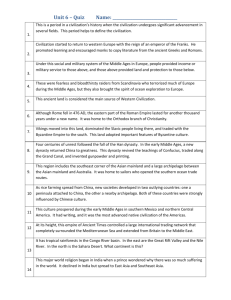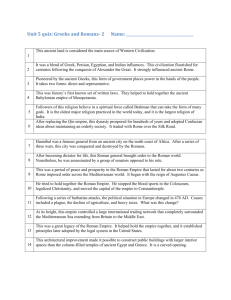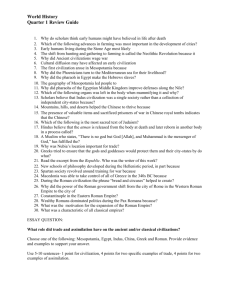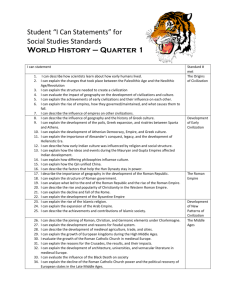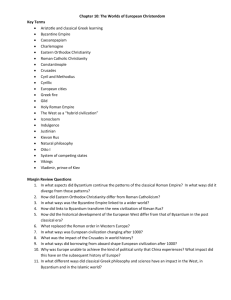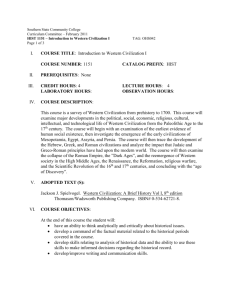Unit 6 Test
advertisement
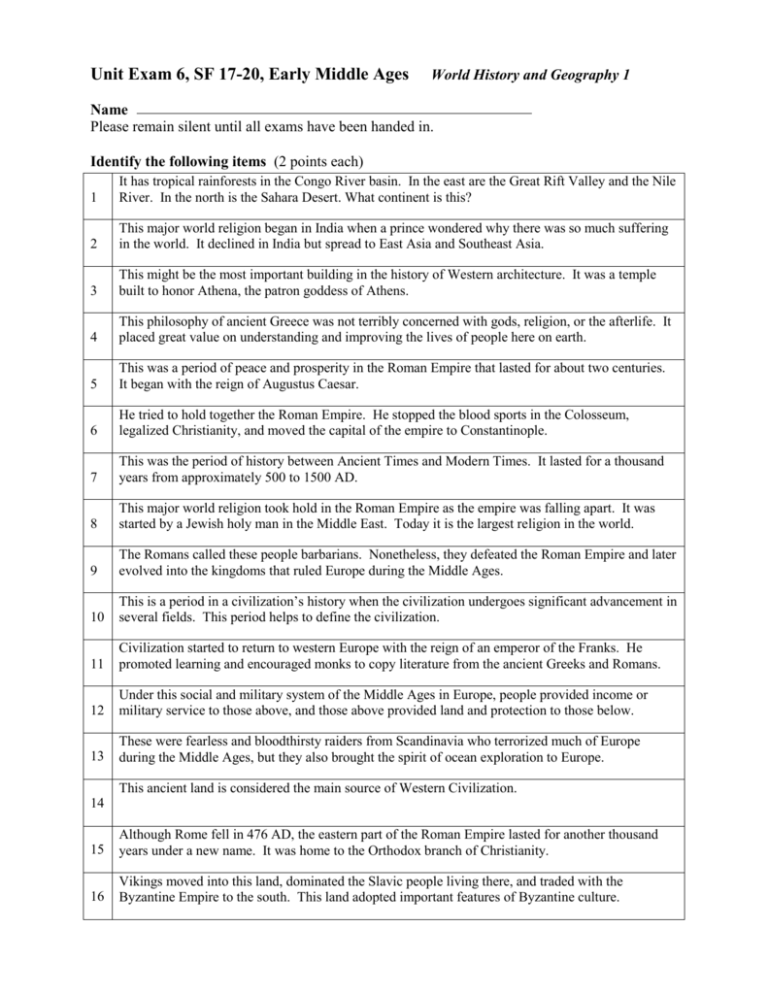
Unit Exam 6, SF 17-20, Early Middle Ages World History and Geography 1 Name Please remain silent until all exams have been handed in. Identify the following items (2 points each) 1 It has tropical rainforests in the Congo River basin. In the east are the Great Rift Valley and the Nile River. In the north is the Sahara Desert. What continent is this? 2 This major world religion began in India when a prince wondered why there was so much suffering in the world. It declined in India but spread to East Asia and Southeast Asia. 3 This might be the most important building in the history of Western architecture. It was a temple built to honor Athena, the patron goddess of Athens. 4 This philosophy of ancient Greece was not terribly concerned with gods, religion, or the afterlife. It placed great value on understanding and improving the lives of people here on earth. 5 This was a period of peace and prosperity in the Roman Empire that lasted for about two centuries. It began with the reign of Augustus Caesar. 6 He tried to hold together the Roman Empire. He stopped the blood sports in the Colosseum, legalized Christianity, and moved the capital of the empire to Constantinople. 7 This was the period of history between Ancient Times and Modern Times. It lasted for a thousand years from approximately 500 to 1500 AD. 8 This major world religion took hold in the Roman Empire as the empire was falling apart. It was started by a Jewish holy man in the Middle East. Today it is the largest religion in the world. 9 The Romans called these people barbarians. Nonetheless, they defeated the Roman Empire and later evolved into the kingdoms that ruled Europe during the Middle Ages. 10 This is a period in a civilization’s history when the civilization undergoes significant advancement in several fields. This period helps to define the civilization. 11 Civilization started to return to western Europe with the reign of an emperor of the Franks. He promoted learning and encouraged monks to copy literature from the ancient Greeks and Romans. 12 Under this social and military system of the Middle Ages in Europe, people provided income or military service to those above, and those above provided land and protection to those below. 13 These were fearless and bloodthirsty raiders from Scandinavia who terrorized much of Europe during the Middle Ages, but they also brought the spirit of ocean exploration to Europe. This ancient land is considered the main source of Western Civilization. 14 15 Although Rome fell in 476 AD, the eastern part of the Roman Empire lasted for another thousand years under a new name. It was home to the Orthodox branch of Christianity. 16 Vikings moved into this land, dominated the Slavic people living there, and traded with the Byzantine Empire to the south. This land adopted important features of Byzantine culture. 17 18 Four centuries of unrest followed the fall of the Han dynasty. In the early Middle Ages, a new dynasty returned China to greatness. This dynasty revived the teachings of Confucius, traded along the Grand Canal, and invented gunpowder and printing. This region includes the southeast corner of the Asian mainland and a large archipelago between the Asian mainland and Australia. It was home to sailors who opened the southern ocean trade routes. 20 As rice farming spread from China, new societies developed in two outlying countries: one a peninsula attached to China, the other a nearby archipelago. Both of these countries were strongly influenced by Chinese culture. After the angel Gabriel told him to recite messages from God, this caravan merchant from Mecca started a major new world religion in the deserts of the Arabian peninsula. 21 This religion worships the same God worshiped by Christians and Jews. Members of this religion are called Muslims, their churches are mosques, and their God is Allah. 22 United by religion, Bedouin tribes from Arabia took control of Persia, Egypt, northern India, North Africa, Spain and parts of the Byzantine Empire. What might we call these victories? 23 This culture prospered during the early Middle Ages in southern Mexico and northern Central America. It had writing, and it was the most advanced native civilization of the Americas. 24 At its height, this empire of Ancient Times controlled a large international trading network that completely surrounded the Mediterranean Sea and extended from Britain to the Middle East. 19 Map Identification Supply the appropriate letter from the map. (1 point each) 25. Yellow River 29. Italy 33. Constantinople (Istanbul) 26. Byzantine Empire 30. Korea 34. Scandanavia 27. Southeast Asia 31. Mecca 35. Arabia 28. Russia 32. China 36. Greece 37. ___ Maya Written response section. On a sheet of notebook paper, use good sentences to write complete and thoughtful answers to the following questions. Support your answers with evidence from history. (5 points each) 38. Describe the Dark Ages. 39. What warning does Maya civilization give us regarding today’s global environment? 40. How might a central civilization affect outlying regions? Extra Credit (4 points possible) XC. Put yourself in the place of a woman living during the early Middle Ages. Would you rather be a member of a serf family in Western Europe, a Muslim family in the Middle East, or a peasant family in China? Why? DON’T FORGET THE MULTIPLE-CHOICE QUESTIONS ON THE LAST PAGE! Multiple Choice. Circle the letter of the best answer (3 points each) 41. Which of the following timelines is correct? a. Trojan War, Socrates, Roman Republic, Charlemagne, Dark Ages, Fall of Rome b. Indus River valley civilization, Gupta Empire, Asoka, Buddha c. Yellow River valley civilization, Confucius, First Emperor, Han Dynasty, Tang Dynasty d. a and c above 42. Which religion united the Bedouin tribes of Arabia? a. Islam d. a and c b. Christianity e. all of the above c. Judaism 43. Which of the following were great classical civilizations of the ancient world? a. The Qin and Han dynasties of China b. The Greek and Roman civilizations of the Mediterranean c. The Mauryan and Gupta dynasties of India d. a and c e. all of the above 44. Which of the following is NOT a feature of feudalism? a. The king was at the top of society, and serfs were at the bottom. b. Through talent and hard work, serfs could become lords. c. Lords owed protection to the serfs. d. Lords owed military service to the king. 45. Germanic tribes a. were called barbarians by the Romans. b. wrote in the Latin language of the Roman Empire. c. were loyal only to local chiefs and fought with one another. 46. Which of the following is a feature of Islam? a. Muslims face Mecca five times a day to pray. b. Muslims are required to help the poor and sick. c. Muslims are encouraged to go on a pilgrimage to Mecca. d. Islamic law applies to business, government, and moral conduct. e. All of the above. f. None of the above 47. These are the two main branches of Islam: a. Shi’a and Sunni b. Mongols and Huns c. Arabs and Israelis d. Orthodox and Catholic 48. Sailors of Southeast Asia a. learned to ride the monsoon winds. b. were fearful of sailing off the edge of the earth. c. pioneered the southern ocean trade routes. d. a and c above d. a and c e. a, b, and c
